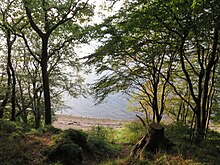Steep slope

In geosciences, a steep slope is a mountain slope or part of a slope with an average slope of more than 1: 2 or more than 30 °.
geology
The emergence of different slopes depends on the one hand on the rock of the mountain slope. B. from the other side of the mountain or valley (opposite slope) - on the other hand from its hardness and storage conditions ( sedimentation , stratigraphy, bank or crevices ), from its resistance to erosion and not least from its water flow and the local climate .
From the point of view of geomorphology , steep slopes differ not only in their inclination and rock type , but above all in their exposure (i.e. their orientation in relation to the cardinal point), their roundness or roughness (small shapes and curvature, steps, terraces , drainage, etc. ), the vegetation on the mountain flanks and the soil formation .
The Ranker soil type got its name from the word "Ranker" for "steep slope", which is common in western Austria.
Natural hazards
Various natural hazards exist on steep slopes if they are not forested and not interrupted by flatter terrain:
- Landslide - especially if the soil after heavy rain or during snow melt is moistened
- Rockslide - if there is a rock face or heavily weathered blocks above , or
- Rockfall (see traffic signs) as a lighter form
- Mudflows caused by storms or avalanches
- episodic or sudden valley thrust , threatening damming up of the water.
Management
Steep slopes of up to around 40 ° can in principle be cultivated - for example for the production of hay or in forestry for the fetching of wood , under favorable climatic conditions also for viticulture . But operating against the competition from flatter landscapes is rarely economical. This is why mountain farmers (their definition depends on the altitude and slope ) are mostly supported by public funds.
This support for alpine forestry and agriculture is in part not only justified, but also necessary. Traditionally, the higher-level regional authorities (especially the federal states ) are responsible for this, because the individual municipalities are hardly able to do so economically. Also geotechnical institutions active in the fields of mining, avalanche protection and tourism as well as the EU are in the promotion of the affected mountainous areas involved.
With meaningful subsidies, mountain farmers are encouraged or enabled to continue to manage their farms or alpine pastures . If this is not done, the damage caused to the general public by the natural hazards mentioned above is usually higher than the costs of subsidy measures. The advantages of protective and promotional measures can be in detail:
- Preservation of protective forests (especially against mudslides and avalanches)
- General landscape protection (" mountain farmers as landscape gardeners")
- Environmental protection (e.g. preservation of soil quality , biodiversity, etc.)
- Tourism (desire for an "intact landscape ", local customs, etc.)
- Torrent and avalanche control
- Protection of traffic routes and stabilization of forest roads
- certain self-sufficiency for the local supply of food and raw materials
- regional aspects of spatial planning .
